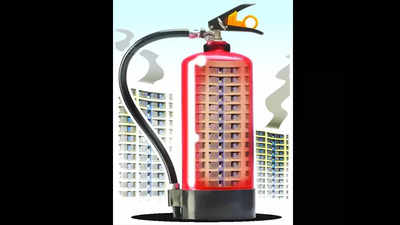- News
- City News
- bengaluru News
- Playing with fire: Safety takes a back seat as rules remain on paper in Bengaluru
Trending
This story is from September 24, 2021
Playing with fire: Safety takes a back seat as rules remain on paper in Bengaluru

Picture for representational purpose only.
BENGALURU: A series of fire accidents in less than a week snuffing out human lives and damaging properties in various parts of the state brought to the fore inadequate safety measures. There’s a lack of firefighting equipment and laxity in emergency preparedness, especially in narrow lanes and high-rise buildings that have mushroomed in recent years.
Initial findings of recent accidents in Bengaluru suggest that storing inflammable materials, blocking exit passages, overhanging electrical wires, non-installation of fire equipment, congested staircases, narrow entry roads and absence of trained personnel to tackle emergencies have either triggered the blaze or worsened the situation.Because of its peculiar nature, fire in residential apartments which lack adequate in-built fire protection systems, becomes more complex and salvaging operations turn out to be more difficult. Case in point: Tuesday’s accident in southeast Bengaluru, where a mother and daughter got stuck in their grilled balconies in an apartment and were charred to death.

“It is not as if the laws are not in place, but enforcing and complying with regulations and guidelines are exceptions rather than rules. The fire department also lacks modern technology and manpower to deal with the situation,” said A Ravindra, former chief secretary and urban expert.
Fire Safety Audit (FSA) is found to be an effective tool to assess fire-safety standards of a building. Although there are many rules and regulations, codes and standards related to fire safety, these are seldom followed by both building owners and the fire department.
According to state home department officials, only 30 per cent of the buildings of nearly 2 lakh highrises (ground + four) in the state have obtained no objection certificates (NOCs), which is a must.
As per norms of the National Building Code-2005, highrises should have fire extinguishers, hose reel, dry/wet riser, automatic sprinkler system, manually operated electric fire alarm systems, automatic detection and alarm system, underground static water storage tank, terrace tank, and so on, but neither the developers, nor the authorities or even the occupants are really concerned about the safety issue.
Though many high-rise buildings and apartments have installed fire fighting equipment, lack of maintenance has made many of them dysfunctional. Hardly any person has the knowledge of using them.
Fire service department officials should visit (audit) above mentioned installations periodically and take appropriate action against erring establishments, but they take action only after a major tragedy strikes, many point out.
BN Ravi Kumar, a social activist, said: “Fire safety has never been a priority for the state governments largely due to lack of resources. Fire services are ill-equipped in providing adequate safety cover to the population.”
Initial findings of recent accidents in Bengaluru suggest that storing inflammable materials, blocking exit passages, overhanging electrical wires, non-installation of fire equipment, congested staircases, narrow entry roads and absence of trained personnel to tackle emergencies have either triggered the blaze or worsened the situation.Because of its peculiar nature, fire in residential apartments which lack adequate in-built fire protection systems, becomes more complex and salvaging operations turn out to be more difficult. Case in point: Tuesday’s accident in southeast Bengaluru, where a mother and daughter got stuck in their grilled balconies in an apartment and were charred to death.

“It is not as if the laws are not in place, but enforcing and complying with regulations and guidelines are exceptions rather than rules. The fire department also lacks modern technology and manpower to deal with the situation,” said A Ravindra, former chief secretary and urban expert.
Highrises with no NOCs
Fire Safety Audit (FSA) is found to be an effective tool to assess fire-safety standards of a building. Although there are many rules and regulations, codes and standards related to fire safety, these are seldom followed by both building owners and the fire department.
According to state home department officials, only 30 per cent of the buildings of nearly 2 lakh highrises (ground + four) in the state have obtained no objection certificates (NOCs), which is a must.
As per norms of the National Building Code-2005, highrises should have fire extinguishers, hose reel, dry/wet riser, automatic sprinkler system, manually operated electric fire alarm systems, automatic detection and alarm system, underground static water storage tank, terrace tank, and so on, but neither the developers, nor the authorities or even the occupants are really concerned about the safety issue.
Though many high-rise buildings and apartments have installed fire fighting equipment, lack of maintenance has made many of them dysfunctional. Hardly any person has the knowledge of using them.
Fire service department officials should visit (audit) above mentioned installations periodically and take appropriate action against erring establishments, but they take action only after a major tragedy strikes, many point out.
BN Ravi Kumar, a social activist, said: “Fire safety has never been a priority for the state governments largely due to lack of resources. Fire services are ill-equipped in providing adequate safety cover to the population.”
End of Article
FOLLOW US ON SOCIAL MEDIA










